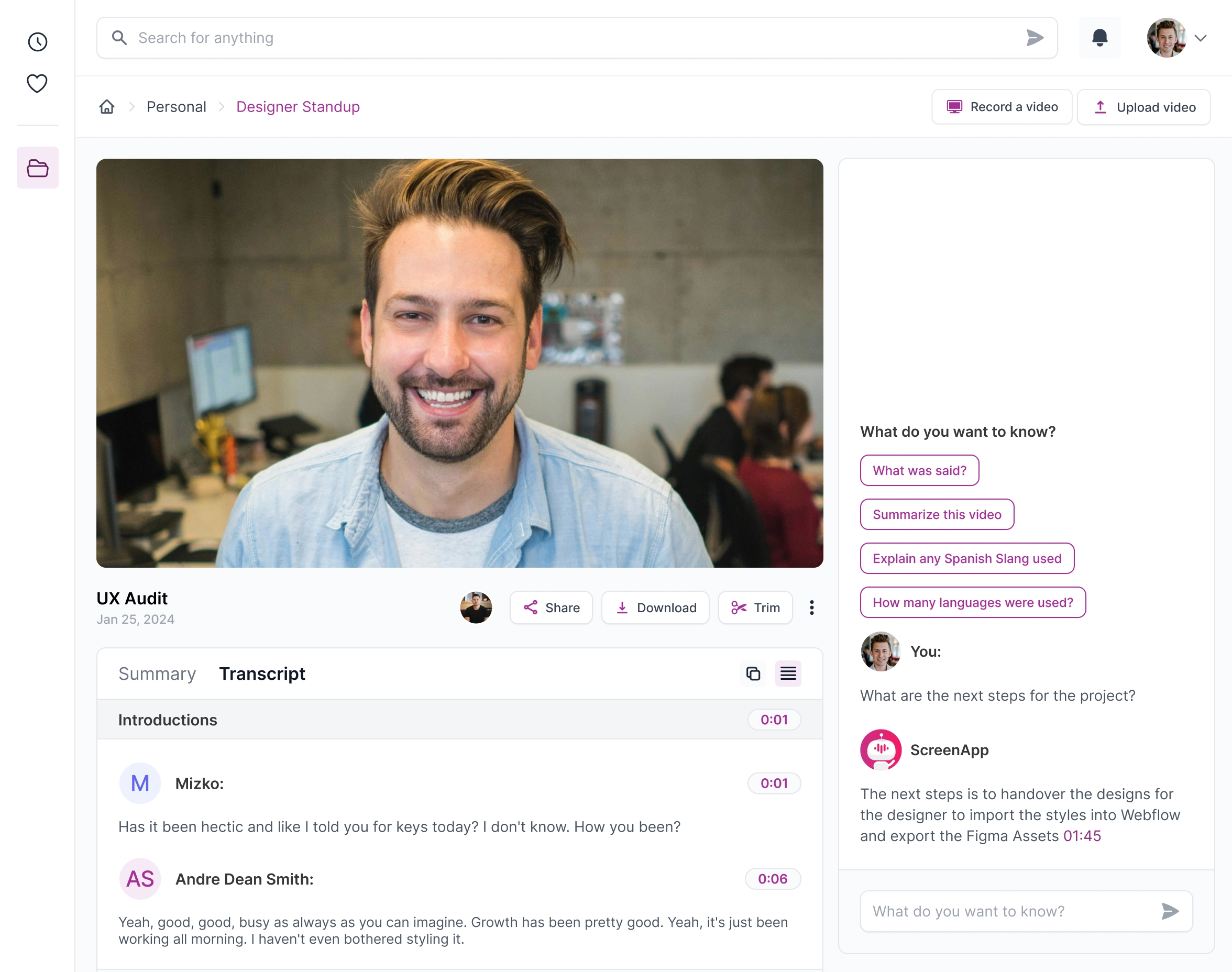AI User Testing Recorder
AI-Powered Audio and Video Recorder for Accurate User Testing

Trusted and Supported by businesses across the world







Discover how ScreenApp revolutionizes user testing with its AI-driven audio and video recording capabilities. Capture every detail, transcribe and summarize effortlessly, and maintain consistency with template generation. Enhance your user testing process with real-time captions and automated note-taking. Explore more on our Features page.
Explore Related Features
.webp)
.webp)
ScreenApp for User Testing
ScreenApp is an audio and video recorder that uses AI to transcribe, summarize, and templatize recordings, making it an excellent tool for user testing. When conducting user tests, it's crucial to capture every detail accurately. ScreenApp allows you to record both audio and video, ensuring that no part of the user interaction is missed. The AI-powered transcription feature converts spoken words into text, making it easier to analyze user feedback. For more information on how to use ScreenApp for user testing, visit our Online Screen Recorder page.
Transcription and Summarization
One of the standout features of ScreenApp is its ability to transcribe and summarize recordings. This is particularly useful in user testing, where you need to sift through hours of footage to find key insights. The AI transcription feature not only converts speech to text but also summarizes the content, saving you valuable time. You can also use the Transcript Summarizer to get concise summaries of your recordings. This makes it easier to identify patterns and areas for improvement in your product.
Template Generation for Consistency
Consistency is key in user testing, and ScreenApp helps you achieve that with its template generation feature. By creating templates for your recordings, you can ensure that each user test follows the same format, making it easier to compare results. This feature is particularly useful for teams that conduct multiple rounds of testing. To learn more about how to create templates, check out our Meeting Notes Template Generator page.
Additional Features for Enhanced User Testing
ScreenApp offers a range of additional features that can enhance your user testing process. For instance, the Online Live Caption Tool can provide real-time captions during user tests, making it easier to follow along. The AI Note Taker can automatically generate notes from your recordings, ensuring that you don't miss any important details. These features, combined with the core functionalities of ScreenApp, make it a comprehensive tool for user testing. Explore more about these features on our Features page.
.webp)
FAQ
What is user testing in ScreenApp?
User testing in ScreenApp involves recording users as they interact with your app or website. This helps you see what works well and what needs improvement.
How do I set up a user test in ScreenApp?
To set up a user test, log in to your ScreenApp account, create a new project, and invite users to participate. You can then record their screens and collect feedback.
Can I test on different devices?
Yes, ScreenApp allows you to test on various devices, including desktops, tablets, and smartphones. This helps you understand how your app or website performs across different platforms.
How do I analyze the results?
After the test, you can watch the recorded sessions and read user feedback. ScreenApp provides tools to highlight key moments and generate reports.
Is user testing in ScreenApp secure?
Yes, ScreenApp ensures that all user data and recordings are securely stored and only accessible to authorized team members. Learn more about our security measures.
Can I share the test results with my team?
Absolutely! You can easily share the recorded sessions and reports with your team members through ScreenApp. This helps everyone stay on the same page.
How many users should I test with?
Testing with 5-7 users is usually enough to identify most usability issues. However, more users can provide deeper insights.
What types of tasks should I give users?
Give users tasks that reflect real-world use cases. For example, ask them to complete a purchase or find specific information. This helps you see how intuitive your app or website is.

